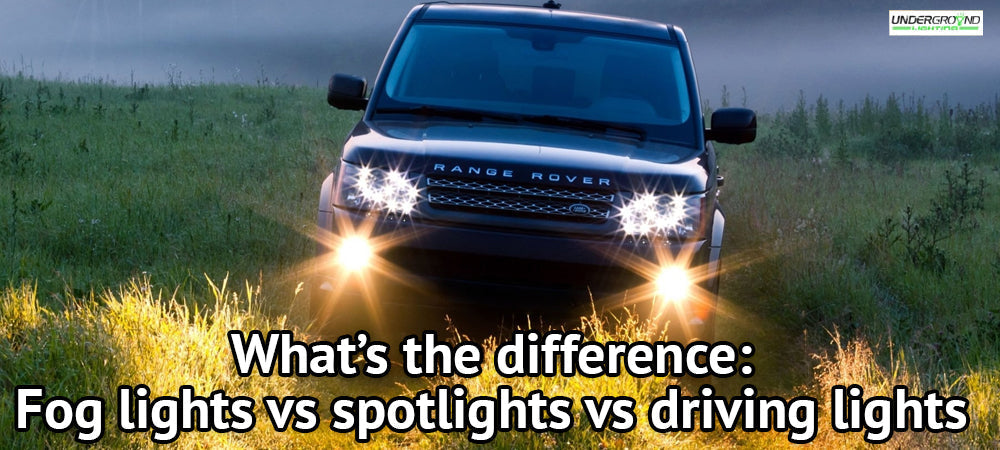What are auxiliary lights?
Auxiliary lights are additional lights mounted on a vehicle to supplement the main headlights and provide extra illumination. They come in a variety of types, including fog lights, spotlights, driving lights, and LED light bars, and they're designed to be used in a variety of driving conditions, such as off-road driving, nighttime driving, and driving in inclement weather.
Auxiliary lights are typically mounted on the front or rear of a vehicle and are used in conjunction with the main headlights. They're often used to provide a wider and longer beam of light, which can help improve visibility and make it easier to see obstacles and animals on the road. Some auxiliary lights are also designed to be used as a style accessory, providing a more aggressive or custom look for the vehicle.
Overall, auxiliary lights are a great addition for anyone who wants to improve their visibility and safety while driving, especially in challenging driving conditions. If you're interested in adding auxiliary lights to your vehicle, be sure to check the regulations in your area, as some types of lights may not be legal in all regions.
Different types of Auxiliary Lights
Fog lights, spotlights, and driving lights are all types of auxiliary lights that are commonly used on vehicles. However, each of these lights serves a different purpose, and it's important to understand the differences between them to make an informed decision about which lights to use for your vehicle. In this article, we'll take a look at what sets fog lights, spotlights, and driving lights apart, and what you can expect from each type of light.
-
Fog Lights
Fog lights are designed to help drivers see the road more clearly in foggy or misty conditions. They're usually mounted low on the vehicle, and they emit a wide, flat beam of light that's angled downward. This beam is designed to penetrate the fog and illuminate the road ahead, helping drivers to see where they're going and avoid obstacles. LED fog lights are a popular choice among drivers, as they offer brighter and more efficient lighting than traditional halogen fog lights.
-
Spotlights
Spotlights, on the other hand, are designed to be used in off-road or nighttime driving conditions. They're usually mounted high on the vehicle, and they emit a focused, long-range beam of light that's angled upward. This beam is designed to help drivers see further down the road or into the distance, making it easier to spot obstacles and animals. Spotlights are typically used in combination with other lights, such as fog lights or driving lights, to provide a comprehensive lighting solution for off-road driving.
-
Driving Lights
Driving lights, also known as daytime running lights (DRL), are designed to be used during the day and are usually mounted in the grille or front of the vehicle. They emit a bright, wide beam of light that's angled downward, and their purpose is to make the vehicle more visible to other drivers on the road. Driving lights are usually turned on automatically when the vehicle is started, and they provide an extra layer of visibility that can help reduce the risk of accidents. LED driving lights are a popular choice for drivers, as they offer brighter and more efficient lighting than traditional halogen driving lights.
Fog lights vs spotlights vs driving lights
In summary, fog lights, spotlights, and driving lights all have unique functions and benefits that make them ideal for different driving conditions. While fog lights are ideal for improving visibility in foggy or misty conditions, spotlights are ideal for off-road or nighttime driving, and driving lights are ideal for making your vehicle more visible during the day.
Fog lights are designed to emit a wide, flat beam of light that's angled downward, helping drivers to see the road more clearly in foggy conditions. They're usually mounted low on the vehicle, and they're an essential piece of equipment for anyone who drives in areas with heavy fog or mist. LED fog lights are a popular choice for drivers, as they offer brighter and more efficient lighting than traditional halogen fog lights.
Spotlights, on the other hand, are designed to provide a long-range beam of light that's angled upward, making it easier to spot obstacles and animals in off-road or nighttime driving conditions. They're usually mounted high on the vehicle, and they offer a powerful beam of light that can reach far into the distance. Spotlights are typically used in combination with other lights, such as fog lights or driving lights, to provide a comprehensive lighting solution for off-road driving.
Driving lights, also known as daytime running lights (DRL), are designed to make your vehicle more visible to other drivers during the day. They emit a bright, wide beam of light that's angled downward, and they're usually mounted in the grille or front of the vehicle. Driving lights are usually turned on automatically when the vehicle is started, and they provide an extra layer of visibility that can help reduce the risk of accidents. LED driving lights are a popular choice for drivers, as they offer brighter and more efficient lighting than traditional halogen driving lights.
Understanding the differences between fog lights, spotlights, and driving lights is essential for anyone who wants to make an informed decision about which lights to use for their vehicle. Whether you're looking for better visibility in foggy conditions, improved off-road performance, or increased visibility during the day, these lights offer a number of benefits that can help you achieve your goals. To learn more about these lights and to find the best options for your vehicle, check out the Underground Lighting auxiliary light collection today.

